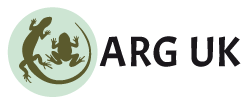About us
About Us
Aim
The aim of this group is to understand and protect the amphibians and reptiles of the Wirral peninsular through organizing training, raising awareness, surveys, habitat management tasks and other conservation activities.
Background
The Wirral Peninsular has historically been habitat of Sand Lizard, Natterjack, Great Crested Newt, Common Frog, Common Toad, Smooth Newt, Palmate Newt, Common Lizard, Slow Worm and Grass Snake. However, developments in the 20th Century has seen species such as the Sand Lizard and Natterjack disappear. Status of other herps have been uncertain, the problem being linked to lack of surveys and recording.
In 2018, preliminary surveys around Wallasey revealed many new and surprising records for amphibians and reptiles. This was part of the Cheshire & Wirral ARG. However, the size of this district with that county was too large, necessitating the formation of a new ARG for Wirral (WiARG) so more surveys and recording can be coordinated across this interesting peninsular.
Founding member and current Chair of WiARG, Tom Doherty-Bone, grew up on the Wirral and was frustrated by the lost herpetofauna species and limited opportunities to view the remaining herps in the area. Formation of this new ARG will create the opportunity for local residents in the Wirral to get involved with amphibian and reptile surveys and recording for both enjoyment of these wonderful animals and to aid in their conservation on the Wirral.
Activities
Since its formation in 2019, WiARG has undertaken numerous surveys and practical conservation tasks across the Wirral. Some of the highlights have been mapping out the extent of Common Lizard in Harrison Park, Wallasey, as well as lizards and amphibians across the North Wirral Coastal Park. Updating the known status of amphibians (including Great Crested Newt) at Royden Park and more recently measuring the use of the tidal zone of amphibians in the north west Wirral coast.
An outline itinerary for 2023-24 can be found under the 'Upcoming surveys' tab, suggestions from members are welcomed.
Existing partnerships include the Wirral Ranger Service, Cheshire Wildlife Trust, the Friends of the North Wirral Coastal Park and Wirral Wildlife.
Committee
The present committee consists of: Thomas Doherty-Bone (chair); Sue Noyce (secretary); Jon Bielby (vice chair); Frankie Bielby (treasurer); Charles Mulryan (general committee); Mike Brown (senior adviser).
Membership
The membership fee for 2023-24 is £5 (£2.50 for under 17s when accompanied by a guardian), which goes toward conservation activities of the group, such as buying equipment. Payment can either be made in cash, bank transfer or through Paypal: https://paypal.me/WiARG?locale.x=en_GB
Membership cycle runs from April to April.
Please get in contact if you wish to get involved.
News
News
Back at Royden Park
On Saturday the 7th December, we were back at Royden Park to improve ponds for Great Crested Newts. This time it was a task that needed one of us to don waders and enter to remove the alder trees growing in the water. While in there we found submerged plants growing underneath, which is encouraging as newts will be able to use these for laying their eggs. As with last time, we used the wood to create a hibernacula, which would provide amphibians and other animals a shelter from extremes in the elements, whether it be extreme cold or even extreme heat, and provide dead wood for saproxylic organisms like fungi and beetles. We also cleared the brambles around the banks, not all of them mind but enough to again, get more light to the water column. We actually know why this is important from attending the Herpetofauna Workers Meeting in 2017, when Dr Carl Sayer presented on farm ponds, showing that ponds allowed to scrub up with woody vegetation had much diminished water quality that was in fact toxic (lots of excess nutrients, sulphates, high turbidity, etc). This indicates that it is not just lack of light, but builds up of excessive dead plant material that encourages microbial activity that likely induces these chemical imbalances. This was noticeable when wading through, and the smells of the "swamp gas" coming out, likely from sulphide-creating microbes. We had a break at the park cafe and finished off. We should be starting on the next bunch of ponds in the new year. Thanks for those volunteers and rangers making this happen.
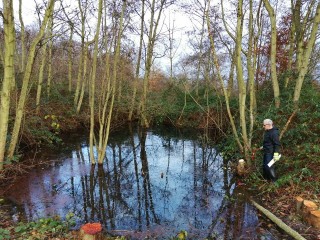
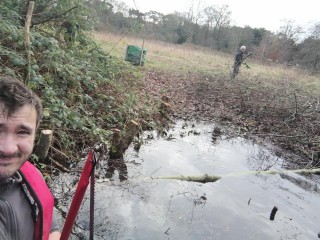
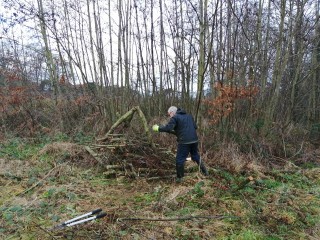
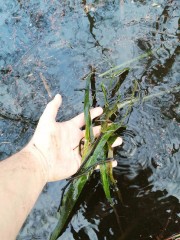
New project: Great Crested Newt Conservation at Royden Park
In partnership with the rangers of the Wirral Council Parks and Countryside Department, the Wirral Amphibian & Reptile Group have initiated a project in Royden Park for Great Crested Newts (Triturus cristatus).
Records for this protected species have been diminishing in Royden Park, as well as other parts of the Wirral. This species has historically declined across Europe, hence its protection status. While it has stabilised and even grown in parts of Britain, it is clear it is in decline on the Wirral based on historical data. The last observation of Crested Newts was two years ago. So, we did a walkover of Royden Park to assess the habitat quality - while the terrestrial habitat of woodland and meadows is fine, the breeding habitat was found to be average to below average for Crested Newts. This included dense shading of ponds by tree growth. One pond was full of invasive New Zealand Pygmyweed. Another (where most historical records from the 1980s were) had practically disappeared, apparently from siltation.
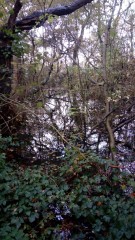
So, we made a plan: each pond would be subject to management practises to bring up their Habitat Suitability Index. This included reducing shade to the ponds, so aspects such as aquatic plants can proliferate, which is good for breeding habitat, and possibly also for the newt's prey: aquatic invertebrates [maybe explained by "green" food webs are empirically found to be more productive than "brown" food webs].
The plan has begun implementation: Last week, a work team that included WiARG volunteers Tom, Kieran & Nathan with rangers Paul & Rosemary and a large team from Friends of Royden Park. We focused on the pond by the meadow. Paul was cutting the larger trees down with the chainsaw, while the rest were clearing the meadow of Turkey Oak (an invasive alien species that has not had as much awareness, see: https://www.woodlandtrust.org.uk/trees-woods-and-wildlife/british-trees/a-z-of-british-trees/turkey-oak/) which has been popping all over and threatening to outshade all the sun-dependent grassland species in the meadow and will likely threaten even woodland species (including the english oak).
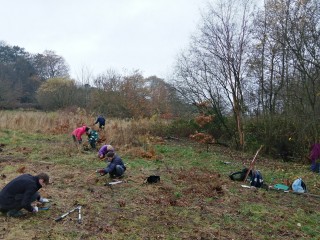
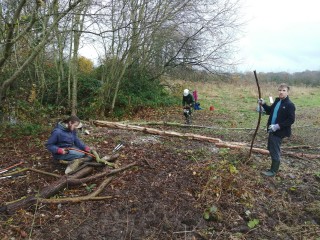
As lots of wood was accumulating, we use it to create some hibernacula. This would act as shelter for newts, other amphibians like frogs and toads, as well as other smaller animals to hibernate during winter. I could also provide basking spots, as well as perching spots for birds, and the wood might even become a substrate for fungi to grow. So an effort to protect one species is benefitting others (theoretically!).
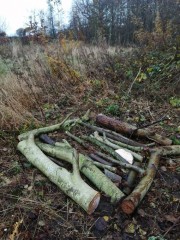
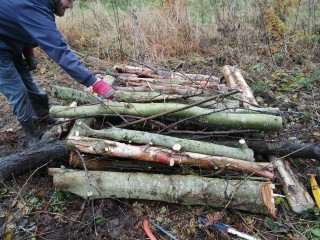
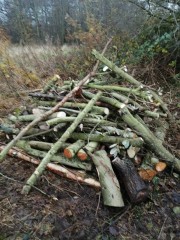
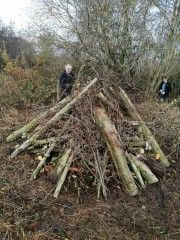
So that one day we made a lot of progress, finishing with the south-facing side of the meadow pond now more expose to the sun, one hibernacula and another started, and the meadow cleared of Turkey Oak. We shall be returning to work on this pond a bit more, then onto another one. In the Spring we shall start monitoring the population of newts. The initial plan was to survey the newts first then do the management, but the population might disappear by then, and this habitat management is already confirmed to benefit their population, but the newts could disappear through non-breeding if we do not act now!
In addition to our group's physical activity, the ranger Paul used our advise to direct management for another pond in Royden. The Wirral Evolutions group, which helps people with learning and physical disabilities reach their potential, took the initiative to remove the New Zealand Pygmyweed from one pond. This involved simply scooping out the weed and leaving it on the side of the pond for any aquatic creatures to return to the pond. As this plant is massively invasive, it could not be moved further in case of escape to another water body and will require constant control each year to stop it becoming dominant. This pondweed can actually remove the water column from a pond, and is sub-optimal for newts to lay their eggs on. However, for the breeding season of Spring 2020, the pond is more suitable for newts to breed in. Great work guys!
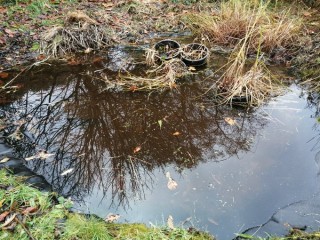
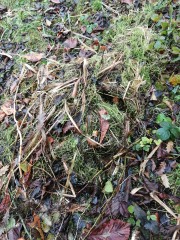
We have another task day planned for the weekend, Saturday 7th December. Thereafter, tasks will continue into January and February. Keep an eye on this website, Twitter and Facebook pages for updates. If you want to be added to the email list and become a member, email the chairman: tommy_dbone@yahoo.com.
Reschedule of Harrison Park Survey from Sat 8th to Sun 9th June
Due to heavy rain forecast for Saturday the 8th June, the planned survey of reptiles at Harrison Park Wallasey has been rescheduled to the following Sunday the 9th.
Same meeting time and place (10 a.m. at carpark off Harrison Drive).
This morning's reptile survey cancelled
Today's reptile survey cancelled: The cloud cover is letting no sun through, so won't be warming up the refugia. Will reschedule for another day soon.
Return to Harrison Park - Lizards Common!
Last Thursday, Tom, Frankie and James got out to Harrison Park and the weather being bright, we got plenty of Common Lizard (Zootoca vivipara), including numerous males with signs of injury that might be masculine combat, but maybe also from predation by corvids. Artificial refugia has now been put out around the area that was burned last year, and the hill where most dog walkers go, no lizards seen yet but there have been incidental reports. Will be an interesting case study.
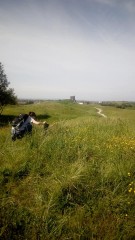
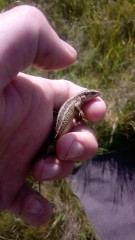
Committee Members
Committee Members

Upcoming Surveys
Upcoming Surveys
There are multiple surveys planned for Friday 24th May at Central Park, Birkenhead Park and Prenton Dell.
Each survey will consist of setting traps and torching ponds on Friday, then returning early on Saturday morning in order to empty the traps and record what's there. As with all surveys, appropriate clothing, water-proof shoes/boots and torches will be useful.
Please use the "check-clean-dry" technique with your outdoor gear for biosecurity. Likewise, if you keep amphibians and reptiles at home, probably use separate clothes if you have been handling or servicing them to save spreading exotic pathogens around.
Let us know if you are planning to attend.
Photo gallery
Photo Gallery
Upcoming Events
Upcoming events will be listed here.
Latest News
- 2024 activities in more detail
27/03/2025 12:35 pm - 2024 - A summary of a busy year
27/03/2025 12:19 pm - Notice of Annual General Meeting and Survey Training Session Sat 25th November Royden Park
28/10/2023 10:46 am - Grass Snake Reports in Ellesmere Port
04/05/2023 3:25 pm - WiARG AGM 12/12/22
06/03/2023 9:57 pm
© Wirral ARG (WiARG)
Website hits: 22709
View All | Find out how to get a mini-website for your ARG
© ARG UK Local Groups mini-websites 2025
Wind powered websites by Aye-aye Design.

